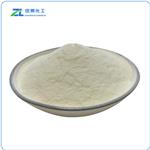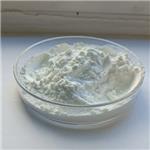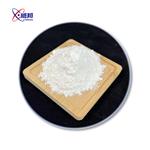Description
Bentonite is a light yellow, creamy, palebrown or gray to black powder or granules. These chemicals contain 1- 24% crystalline silica (O2Si). Specificgravity (H2O:1)=2.5. Hazard Identification (based onNFPA-704 M Rating System): Health 2, Flammability 1,Reactivity 0. Insoluble in water
Chemical Properties
Bentonite is a crystalline, claylike mineral, and is available as an
odorless, pale buff, or cream to grayish-colored fine powder, which
is free from grit. It consists of particles about 50–150 mm in size
along with numerous particles about 1–2μm. Microscopic examination
of samples stained with alcoholic methylene blue solution
reveals strongly stained blue particles. Bentonite may have a slight
earthy taste.
Chemical Properties
Bentonite is a light yellow, creamy, pale
brown or gray to black powder or granules.
Uses
filler in cosmetics and other products, gel, or solid if dry
Uses
Bentonite is a general purpose additive that is used as a pigment and
colorant and to clarify and stabilize wine.
Uses
bentonite (bentonite clay) is used to regulate the viscosity and suspension properties of a cosmetic formulation. It also acts as an overall formula stabilizer. Bentonite’s water-absorption capabilities allow it to form a gelatinous mass. Considered a noncomedogenic raw material, bentonite is a colloidal aluminum silicate clay.
Uses
As of Fuller's earth; as emulsifier for oils; as a base for plasters. Pharmaceutic aid (suspending agent).
Definition
A type of clay
that is used as an adsorbent in making
paper. The gelatinous suspension it forms
with water is used to bind together the
sand for making iron castings. Chemically
bentonite is an aluminosilicate of variable
composition.
Production Methods
Bentonite is a native, colloidal, hydrated aluminum silicate, found in
regions of Canada and the USA. The mined ore is processed to
remove grit and nonswelling materials so that it is suitable for
pharmaceutical applications.
General Description
Bentonite is comprised primarily of the smectite group (montmorillonite) of clay minerals. It is widely used in various industrial applications such as clarification of edible and mineral oils, paints, cosmetics, and pharmaceuticals. It is also used as an adsorbent for the elimination of pollutants from wastewater.
The swelling property of bentonite is used to produce viscous water suspensions for bonding, plasticizing, and suspending applications. The presence of a large surface area of bentonite is due to the colloidal dispersion of the particles is the main reason for its application as an insecticide carrier, an emulsifier, and an emulsion stabilizer.
Agricultural Uses
Clays exist in many forms, of which montmorillonite is
one form. Kaolinite and montmorillonite, which are clay
minerals, have different layer structures with differing
abilities to absorb and retain water, and to adsorb and
exchange cations.
Montmorillonites have an expanding structure (2: 1)
and have high cation exchange capacity (80 to 120 mg per
100 g). They have abundant black clay soils. Other
minerals in this group are biedellite and nontronite.
Pharmaceutical Applications
Bentonite is a naturally occurring hydrated aluminum silicate used
primarily in the formulation of suspensions, gels, and sols, for
topical pharmaceutical applications. It is also used to suspend
powders in aqueous preparations and to prepare cream bases
containing oil-in-water emulsifying agents.
Bentonite may also be used in oral pharmaceutical preparations,
cosmetics, and food products. In oral preparations,
bentonite, and other similar silicate clays, can be used to adsorb
cationic drugs and so retard their release. Adsorbents are also
used to mask the taste of certain drugs.
Bentonite has been investigated as a diagnostic agent for
magnetic resonance imaging.
Therapeutically, bentonite has been investigated as an adsorbent
for lithium poisoning.
Agricultural Uses
Bentonite, also known as montmorillonite, volcanic
clay, soap clay and amargosite, is a soft, plastic, lightcolored,
porous rock consisting largely of colloidal
silica. Composed essentially of clay minerals, it swells
extensively when wet. Bentonite belongs chiefly to the
montmorillonite group and has two varieties: (a) sodium
bentonite, with a high swelling capacity in water, and
(b) calcium bentonite, with negligible swelling capacity.
Bentonite is used variously as a suspending aid, a
gelatinous slurry to extinguish fire, a paint thickener, and
as a sealant for earthen pots. Bentonite is also widely used
in metallurgy, soap manufacture, and in petroleum
refining because of its high decolorizing power and
strong adsorbing capacity.
Safety Profile
Poison by intravenous
route causing blood clotting. Questionable
carcinogen with experimental tumorigenic
data.
Safety
Bentonite is mainly used in topical pharmaceutical formulations but
has also been used in oral pharmaceutical preparations, food
products, and cosmetics.
Following oral administration, bentonite is not absorbed from
the gastrointestinal tract. Bentonite is generally regarded as a
nontoxic and nonirritant material.
LD
50 (rat, IV): 0.035 g/kg
Potential Exposure
This material is used as Fuller’s earth;
as a mineral, natural, or synthetic fiber; as an emulsifier for
oils; as a base for plasters; in cosmetics, in polishes and
abrasives; as a food additive and others. Bentonites are aluminate
silicate and can contain crystalline silica. The content
varies widely from less than 1% to about 24% .
First aid
Inhalatio Move person to fresh air. Seek medical attention if necessary. Skin: Wash with water. Eyes:Wash with water as needed. Seek medical attention if necesvsary.
storage
Bentonite is hygroscopic, and sorption of atmospheric water should
be avoided.
Aqueous bentonite suspensions may be sterilized by autoclaving.
The solid material may be sterilized by maintaining it at 1708℃ for 1
hour after drying at 1008℃.
Bentonite should be stored in an airtight container in a cool, dry
place.
Shipping
Bentonite is not cited in the DOT Performance-
Oriented Packaging Standards.
Incompatibilities
Aqueous bentonite suspensions retain their viscosity above pH 6,
but are precipitated by acids. Acid-washed bentonite does not have
suspending properties. The addition of alkaline materials, such as
magnesium oxide, increases gel formation.
Addition of significant amounts of alcohol to aqueous preparations
will precipitate bentonite, primarily by dehydration of the
lattice structure.
Bentonite particles are negatively charged and flocculation
occurs when electrolytes or positively charged suspensions are
added. Bentonite is thus said to be incompatible with strong
electrolytes, although this effect is sometimes used beneficially to
clarify turbid liquids.
The antimicrobial efficacy of cationic preservatives may be
reduced in aqueous bentonite suspensions, but nonionic and anionic
preservatives are unaffected.
Bentonite is incompatible with acriflavine hydrochloride.
Incompatibilities
Substance is a weak acid in water; avoid
contact with strong alkaline material. Incompatible with
oxidizers (chlorates, nitrates, peroxides, permanganates,
perchlorates, chlorine, bromine, fluorine, etc.); contact may
cause fires or explosions. Keep away from alkaline materials,
strong bases, strong acids, oxoacids, epoxides.
Waste Disposal
Land fill disposal.
Regulatory Status
Accepted in Europe as a food additive in certain applications.
Included in the FDA Inactive Ingredients Database (oral capsules,
tablets and suspensions, topical suspensions, controlled release
transdermal films and vaginal suppositories). Included in nonparenteral
medicines licensed in the UK. Included in the Canadian List
of Acceptable Non-medicinal Ingredients.



